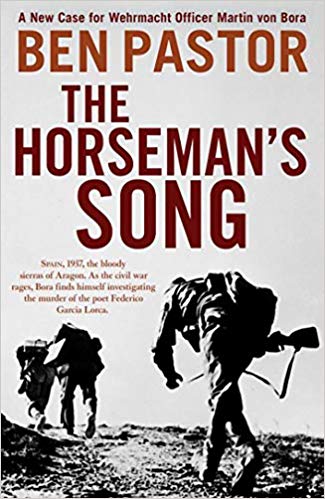The Horseman’s Song: A Novel
- By Ben Pastor
- Bitter Lemon Press
- 376 pp.
- Reviewed by Kathleen R. Hammond
- May 16, 2019
The latest in the Martin Bora series weaves an intriguing mystery at the expense of accuracy.

In July 1936, fascist Nationalist military forces who were aligned with the Spanish Catholic church and wealthy classes revolted against the duly elected liberal democracy, the Spanish Republic. Forces loyal to the republic fought back with unexpected ferocity.
The Spanish Civil War unleashed by the fascist uprising raged for three years, ultimately engaged international forces on both sides, and resulted in the deaths of hundreds of thousands. Those who perished died not only on the battlefields; more than half were slaughtered in bloody reprisals during and after the war.
While both Nationalists and Republicans were guilty of atrocities behind the lines, fascist repression was particularly fierce as the rebel forces swept the country between 1936 and 1939. Many of the dead lie in mass graves or roadside ditches, their bodies unidentified to this day.
Among the remains that have not been found are those of Federico García Lorca, the renowned Spanish poet and dramatist who was arrested by fascist officials and later executed outside Granada in the early hours of August 19, 1936.
The Horseman’s Song is Ben Pastor’s sixth historical novel featuring Detective Martin Bora. In the latest book, Pastor uses the uncertain location of Lorca’s body to posit that he survived the events of 1936, fled Granada, and was subsequently assassinated under mysterious circumstances in the mountains of Aragón in 1937.
Bora appears as a German lieutenant attached to Franco’s Nationalist forces in Aragón. While alone in a valley in the sierras outside Teruel, he discovers Lorca’s body. Lorca has been shot once in the head.
The detective leaves the valley in order to inform his commander of the discovery. The commander, who immediately understands the political importance of controlling the narrative of Lorca’s death, orders that the body be recovered.
During Bora’s absence, Republican militia headed by American Philip Walton find the body. Walton has a personal connection with Lorca and is incensed at Lorca’s execution, which he assumes was carried out by the Nationalists.
Both Bora and Walton dedicate themselves to discovering the murderer: Bora because he is deeply affected by Lorca’s poetry, and Walton because of his friendship with the poet. Ultimately, they form an awkward alliance to find the killer.
It is true that experts in Spain have been unable to identify the location of Lorca’s remains. There is, however, little argument that he was executed by fascist Nationalists near Granada in 1936. For those familiar with the history, a novel based on the assumption that he survived the events of 1936 is uncomfortably implausible. Nonetheless, the plot does allow Pastor to offer some insight into the Spanish Civil War, a subject that Americans often know little about.
Pastor generally does an excellent job describing the daily life of a soldier on both sides of the conflict, lives that vacillated between tedium and terror with a constant drumbeat of discomfort and hardship. Part of that discomfort and hardship was attributable to the inhospitable Spanish sierras. The Republican militia and Bora’s Nationalist troops are encamped opposite one another in the mountains.
Pastor spends a great deal of energy describing the harsh landscape, vegetation, and smaller species of those sierras. Unfortunately, the description is overdone. The action, at times, completely stalls as the reader waits for yet another lizard to slither over a rock in “the beating-down sunlight.”
When the action does proceed, it is Bora who holds the center of the narrative. He represents one of many Germans attached to fascist forces battling the Spanish left. His efforts to uncover Lorca’s murderer drive the action.
Readers of the series will be familiar with Bora’s philosophical ruminations, and we share those ruminations in Horseman. In this iteration, Bora becomes enamored of the works of Lorca, who was generally acknowledged to be a left-wing poet and dramatist.
Bora is an officer in the German fascist military. And while it is not unimaginable that a fascist officer would appreciate the depth of Lorca’s work, it does take some effort on the author’s part to develop and resolve the incongruity. That development does not clearly emerge in Horseman.
Bora’s opposite in the Republican militia, Philip Walton, is a tortured, muddled version of Hemingway’s Robert Jordan in For Whom the Bell Tolls, but his character generates no compassion or sense of connection. One regrets Jordan’s impending doom. Not so with Walton.
Pastor has chosen Spain during the Spanish Civil War as the setting for this adventure. The historical and geographic contexts emerge through a sprinkling of Spanish phrases, geographical descriptions, political allusions, and cultural references. Unfortunately, many of them are inaccurate. The list is too long to enumerate.
However, it is not an auspicious beginning when the title to the first chapter announces, incorrectly, that Aragón is in “North-Western Spain.” It is also unfortunate that the correct Spanish title for Lorca’s poem, which serves as the title of the book in English, has an incorrectly placed accent mark throughout.
For followers of the series, The Horseman’s Song may be a worthy read as a mystery novel: Bora’s character does purport to successfully resolve the supposed riddle of Lorca’s death. Otherwise, it is unsatisfying, stylistically difficult, and inaccurate.
Kathleen R. Hammond is a retired lawyer, Spanish instructor, and student of the Spanish Civil War. Previously, she has published short stories and assisted in the translation of academic articles.

